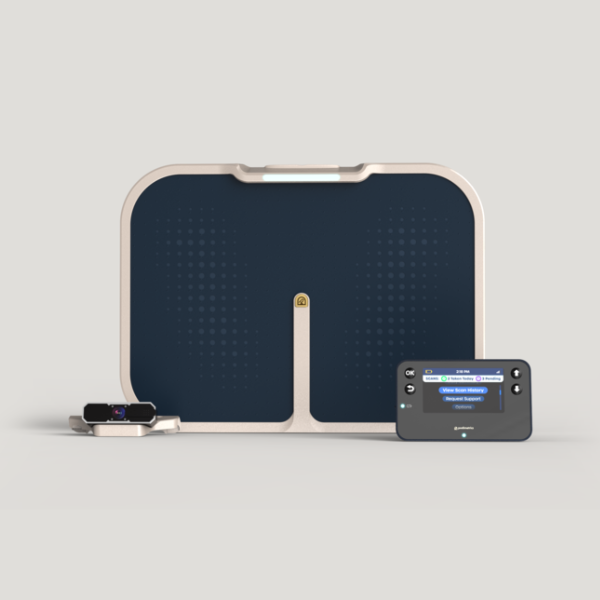By Jon Bloom, M.D., CEO and co-founder of Podimetrics
RTM: Evidence-backed impact on an acute health crisis
Prompt detection and management of diabetic foot ulcers (DFUs) is a crucial component of effective, comprehensive care for patients with type 2 diabetes (T2D). Left unchecked, DFUs can quickly lead to a series of acute complications, including infection, lower extremity amputation (LEA), and mortality. But sadly, that life-threatening sequence remains a pervasive, growing challenge in the T2D patient population, as well as a mounting crisis for the U.S. health system: DFU remains the No. 1 cause of all LEAs in the U.S.1, each of which can cost the health system as much as $100,0002.
Fortunately, digital innovation is making a fast-growing impact on management of this condition—particularly in the form of remote temperature monitoring (RTM) methodologies. RTM enables patients and their care providers to identify areas of inflammation and ulcer formation and intervene proactively to stop the spiral of life-threatening complications that often ensues. Not surprisingly, this approach has quickly become an essential tool for preventing the most severe complications of DFU, including LEA. Compelling evidence has already been amassed to demonstrate RTM’s impact on many factors in the DFU challenge, including incidence rates, T2D-related amputations, and attendant resource utilization3.
New VHA data on DFU prevention add fresh support for RTM
Recently, the RTM literature was further expanded by a retrospective cohort study that focused specifically on patients served by the Veterans Health Administration (VHA)4.
This study is not only one of the largest to date in this space—with nearly a thousand (924) Veterans included in its analyses—but also a valuable contribution to the existing research on RTM deployment in this population. Veterans are often severely impacted by DFU5, and their care is frequently complicated by both extensive comorbidities and high barriers to care access and treatment adherence—so evidence that can help further guide and enhance that care is, as always, most welcome. As a result, we were encouraged to see the results of this study: they clearly indicate that the life-saving benefits of RTM observed elsewhere in the literature extended to even one of the most challenging T2D populations.
At the VHA, the SmartMatTM Program helped save the lives of over 300 veterans with DFU
In fact, the study’s analyses showed that enrollment was associated with a 37% reduction in 1-year mortality (RRR=0.37), adjusted for patient complexity—an outcome that equates to one life saved for every 23 enrollees in the first 12 months alone4.
These results suggest that the SmartMat Program may have helped save the lives of nearly 300 Veterans in the study population. But while that outcome is impressive on its own, it is even more remarkable given the prevalence of rural residency in this population and the related challenges many VHA patients face in both accessing and maintaining care. Evidence on social determinants of health in VHA patients indicates that it likely required up to two hours of driving time for many of these program enrollees to receive care6.
And yet, participating in the SmartMat Program helped hundreds of these patients access and adhere to life-saving preventive measures in their own homes. These findings are consistent with—and further expand—the robust literature on both the mortality associated with DFU, as well as RTM’s effectiveness in reducing it. Validated modeling of the cascading health impact of DFUs has shown that all-cause hospitalization is 2.8 times more likely and all-cause mortality is 1.5 times more likely during DFU episodes7.
To curtail this life-threatening cascade, no less than three randomized controlled trials have already demonstrated that an RTM program can help enhance overall health outcomes for patients with DFUs8-10
These clinical results are further supported by analysis of real-world patient data, which emphatically reinforces RTM’s value in reducing the incidence, complications, and morbidity associated with DFUs3.
The study’s surprising findings warrant further inspection
At the same time, this study also offered several conclusions that diverge from the existing literature in ways that are important to both consider and contextualize. There are some perplexing internal inconsistencies in its findings: Notably, while participants in the RTM group were found to be at significantly lower risk of mortality, the study nonetheless found no association between RTM program enrollment and the upstream clinical events and resource utilization that typically precede mortality4.
These results appear to run directly counter to a familiar, well-documented cascade of complications: ulceration, infection, hospitalization, amputation, and mortality. Robust modeling of DFU episodes of care has shown that this is a typical sequence of events for affected patients7. At the same time, existing evidence also indicates that this sequence is also one RTM can effectively intercept: In a general population of T2D patients, early prediction and identification of DFU has been shown to help prevent limb-threatening complications, reduce resource utilization in the form of emergency department visits and hospital stays, and ultimately drive down patient mortality3.
As the authors of the study noted themselves, the lack of corresponding reduction in hospitalization and limb amputation in the RTM group is an unexpected finding, a surprising diversion from clinical experience, and challenging to interpret. Since these conclusions seem to conflict with existing literature, they warrant a closer look to ensure we fully understand what they can tell us about the impact of the SmartMat Program—both on a general population of T2D patients and on historically challenging ones like Veterans.
An important data gap may have inflected the study’s outcomes
First, it is important to note a key limitation of the study that may help to explain some of its more surprising results. As a retrospective study, the investigators did not have access to one crucial patient parameter that was unavailable in the administrative data the authors relied on: the time between participants’ enrollment in the program and the closure of the prior wound. Multiple studies have shown this to be one of the largest independent predictors of a recurrent wound, with risk decreasing dramatically over time5,11—a correlation that was also highlighted in NEJM and JAMA publications12,13.
These key data were unavailable for this recent study, so the investigators were unable to differentiate between patients with a history of ulceration versus those with an active or recently closed ulcer during the analyzed study period. This is a critical distinction to consider, as patients with relatively recent ulcers would naturally have an increased risk of hospitalization and amputation. Without this vital piece of information, the investigators were unfortunately unable to control for the degree of tissue remodeling achieved by patients in either the study or control group, making it challenging to ensure that the groups were optimally balanced to facilitate the most informative and accurate comparison.
This is especially important given the long and complex healing gradient associated with DFUs: post-epithelialization, full closure can take anywhere from 6-12 weeks for mild wounds to as much as 18 months for patients with Charcot foot (like the 163 individuals included in the study’s RTM group). As such, we have to consider the possibility that the authors’ unexpected findings stemmed—at least in part—from unintended differences between the RTM and comparison groups that developed during patients’ extended healing period.
Unfortunately, the vast majority of program participants at the VHA are enrolled after a podiatry or wound care visit—a reality that likely biased the RTM arm toward more recent previous wounds. If true, this would act to minimize the difference between the groups and underreport clinical findings. This means that even without the benefit of specific wound timing data for the participants in the study, it is reasonable to suspect that the patients enrolled in the SmartMat Program may have skewed toward higher acuity and greater likelihood of ulcer recurrence than the comparison group. This would help shed light on both the seeming conservatism of the findings for the RTM group, as well as their unusual departure from common, well-documented clinical experience.
The VHA and beyond: Continuing the investigation of DFU prevention with RTM
Given these unusual results, we echo the authors’ observation that additional studies are needed to overcome the limitations of this effort and provide more insight into these unexpected findings. Overall, however, the study reinforces the life-saving impact of RTM initiatives like the SmartMat Program—incuding 46% reduction in all DFUs3, 91% reduction in severe DFUs3, 50-80% reduction in LEAs14, and many other findings that robustly support the efficacy of this technology. The reduction in mortality demonstrated by this recent study is particularly noteworthy, as it indicates that nearly 300 more Veterans may still be with us today on account of their enrollment in the SmartMat Program. That’s 300 people who are still cheering on grandkids, participating in their communities, and enjoying their everyday lives—the outcomes we all want to see. We at Podimetrics are continually encouraged by life-changing and life-saving results such as these, and we’re especially excited to see them in important and challenging populations such as VHA patients.
Above all, we applaud this study for its insightful and informative analysis, and particularly for its focus on such an important subgroup of T2D patients. As always, it is important to consider many different factors when determining what these studies can tell us about how to maximize the impact of solutions like RTM. With the right context and perspective, we believe that data like these will always be helpful in optimizing the care we’re able to provide.
But perhaps most of all, we value this contribution to the evidence regarding the SmartMat Program and look forward to future discussions and insights!
References:
- ADA. Economic costs of diabetes in the U.S. In 2007. Diabetes Care. 2008;31:596–615.
- Gorman A. Diabetic Amputations A “Shameful Metric” Of Inadequate Care [Internet]. California Healthline. 2019. Available from: https://californiahealthline.org/news/diabetic-amputations-a-shameful-metric-of-inadequate-care/
- Isaac AL, Swartz TD, Miller ML, Short DJ, Wilson EA, Chaffo JL, et al. Lower resource utilization for patients with healed diabetic foot ulcers during participation in a prevention program with foot temperature monitoring. BMJ Open Diabetes Research & Care. 2020 Oct;8(1):e001440.
- Littman AJ, Timmons AK, Korpak A, Chan KCG, Jones KT, Shirley S, Nordrum K, Robbins J, Masadeh S, Moy E. Evaluation of the Effectiveness of Remote Foot Temperature Monitoring for Prevention of Amputation in a Large Integrated Health Care System. Diabetes Care. 2023 Aug 1;46(8):1464-1468. doi: 10.2337/dc22-1492. PMID: 37319007.
- Rothenberg GM, Page J, Stuck R, Spencer C, Kaplan L, Gordon I. Remote Temperature Monitoring of the Diabetic Foot: From Research to Practice. Federal Practitioner [Internet]. 2020;37(3):114–24. Available from: https://www.ncbi.nlm.nih.gov/pmc/articles/PMC7170172/
- U.S. Department of Veterans Affairs, Veterans Health Administration Office of Health Equity. National Veteran Health Equity Report 2021. Available from: https://www.va.gov/HEALTHEQUITY/docs/NVHER_2021_Report_508_Conformant.pdf
- Petersen BJ, Linde-Zwirble WT, et al. Higher rates of all-cause mortality and resource utilization during episodes-of-care for diabetic foot ulceration. Diabetes Res Clin Pract. 2022 Feb;184:109182. doi: 10.1016/j.diabres.2021.109182.
- Lawrence A, Lavery KR, et al. Preventing Diabetic Foot Ulcer Recurrence in High-Risk Patients: Use of temperature monitoring as a self-assessment tool. Diabetes Care. 2007 Jan 1;30(1):14–20. doi: 10.2337/dc06-1600.
- Lawrence A. Lavery KR, et al. Home Monitoring of Foot Skin Temperatures to Prevent Ulceration. Diabetes Care. 2004 Nov 1;27(11):2642–2647. doi: 10.2337/diacare.27.11.2642.
- Armstrong DG, Holtx-Neiderer K, et al. Skin Temperature Monitoring Reduces the Risk for Diabetic Foot Ulceration in High-risk Patients. Am J Med. 2007 Dec;120(12). doi: 10.1016/j.amjmed.2007.06.028
- Dasari N, Jiang A, et al. Updates in Diabetic Wound Healing, Inflammation, and Scarring. Semin Plast Surg. 2021 Aug;35(3):153-158. doi: 10.1055/s-0041-1731460.
- Armstrong DG, Boulton AJM, Bus SA. Diabetic Foot Ulcers and Their Recurrence. New Eng J Med. 2017 June 15;376(24);2367-2375. doi:10.1056/NEJMra1615439
- Armstrong DG, Tan T, Boulton AJM, Bus SA. Diabetic Foot Ulcers: A Review. JAMA. 2023;330(1):62–75. doi:10.1001/jama.2023.10578
- Podimetrics data on file





